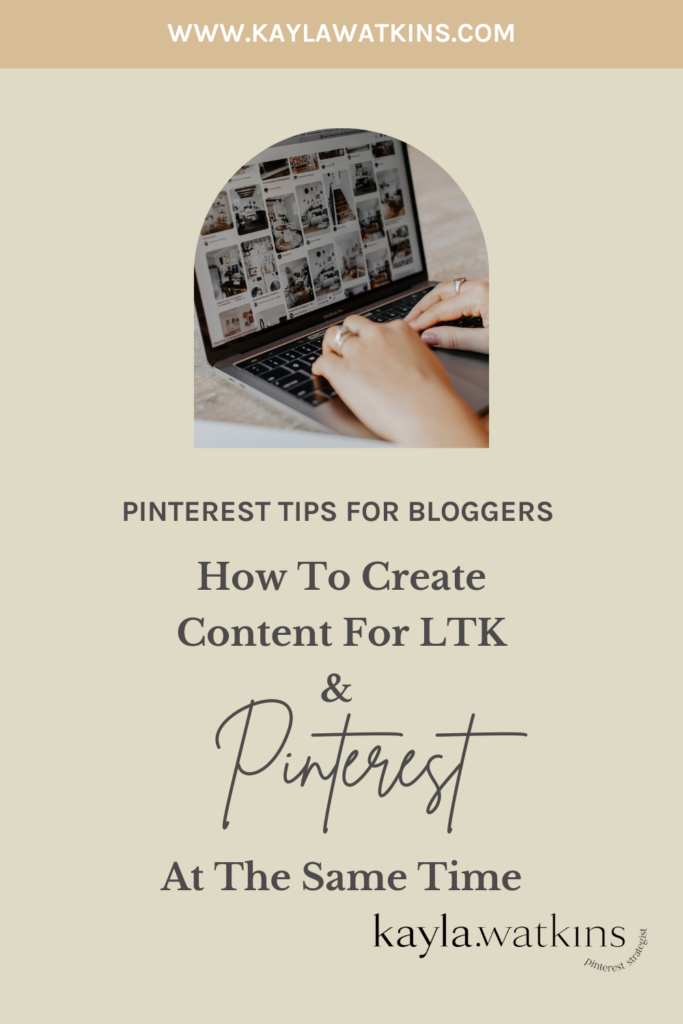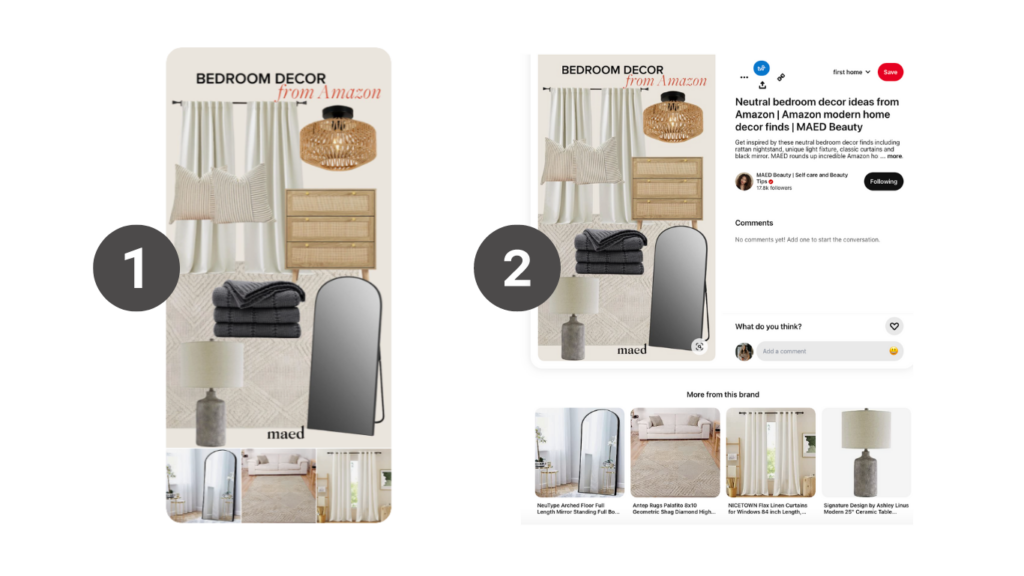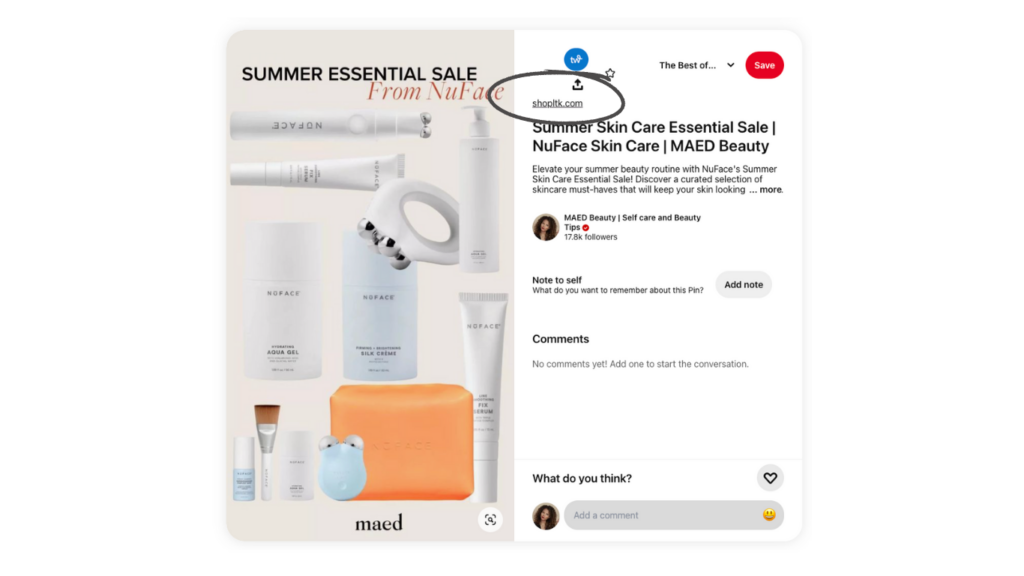How To Create Content For LTK & Pinterest At The Same Time
August 28, 2023
I know that LTK (formerly RewardStyle) is an integral part of your content creator/ blogging business, and it’s been fun to help our clients strategically sell on Pinterest and add to that passive income stream. This works for whatever affiliate marketing platform you’re on. We work most frequently with Amazon Associates, Collective Voice (formerly ShopStyle) and (LIKEtoKNOW.it), but I’ll be phrasing this post to specifically talk about LTK & Pinterest.
Why Pinterest Is a Game-Changer for LTK Content
I’ve said this maybe 3 billion times, but Pinterest isn’t just another social media platform—it’s a powerful visual search engine. Unlike Instagram or TikTok, Pins remain discoverable for months (even years) after posting, giving your LTK content long-term exposure.
Key Benefits of Using Pinterest for LTK Content:
- Extended Lifespan: Pins don’t expire, so a single post can drive traffic to your LTK links for years.
- High Purchase Intent: Pinterest users are actively looking for inspiration and products, making them more likely to purchase via your links.
- Niche Audience Reach: Tailor your Pins to specific interests like “minimalist fashion” or “cozy home decor” to attract engaged audiences.

The Best Way to Share Affiliate Links on Pinterest
Why Blog Posts Work Best for Making Affiliate Sales
The customer journey of a Pinner is very specific: they want solutions, inspiration or tutorials > they go onto Pinterest’s home feed > they search via broad keywords and get more detailed based on what Pinterest shows them > they scroll until they find something that catches their eye or that has text overlay that speaks exactly to their intended search > they click the Pin to see it larger > they click the pin to get the valuable information.
They do not know the content creator or blogger that makes that valuable information, they just know what information they want and once you provide that to them: they shop. Since Pinterest users are cold to you, they care more about information you can provide them than you. LTK posts do not provide the same information or connection. There are not enough characters in that post to warm up new people. That is why promoting blog posts that contain affiliate links on Pinterest is my #1 recommendation for making more money on Pinterest.
Additional Benefits to Promoting Your Blog Posts on Pinterest
The other reason is that I will always recommend you point people to the part of the internet you own. Pinterest sends traffic to where you link for years and years. If LTK disappears or changes its links or does something drastic, you’ll lose that traffic. When you have it linked to your site, you’ll get that traffic forever AND you can convert how you need.
When a new user comes to your website for “10 Fall Dresses to Wear to a Wedding,” for example, you can do the following:
- sell them dresses via affiliate links
- convert them to e-mail subscribers
- direct them to similar content so they hang out with you longer
- convert them to social media followers
If you direct to LTK, you can:
- sell them dresses via affiliate links
See the difference? Let’s get into how to make the content creation process quicker when it comes to creating LTK posts that you know will be pins one day.
Pin This for Later:

How to Optimize Your Content Creation Process
Creating Content for LTK and Pinterest Simultaneously
My favorite way to explain things is with an example so that we can more clearly understand the workflow for creating LTK posts and Pins in a strategic, efficient way. Let’s say you’re a fashion blogger that has an outfit you want to share.
- Take a vertical photo of it
- Take a short, vertical video of it
- Create the post on LTK and include all of the products
- Take the products and create a vertical product college graphic
Now that one outfit becomes 3 LTK posts and 3 pins.


How to Optimize LTK Posts for Pinterest
Choosing the Right LTK Post Dimensions for Pins
Pinterest recommends a 2:3 aspect ratio (e.g., 1000 x 1500 pixels). This size ensures your Pins stand out without being cut off in feeds. Use this size for both your lifestyle photos (outfit photos, skincare line up, etc.) and your custom, branded Pin graphics. If you automatically do this for LIKEtoKNOW.it, you’re more quickly able to repurpose it to Pinterest.
When creating graphics to promote your LTK post further use Canva to create Pin templates that you can reuse. Make sure your design includes:
- Bold, legible text overlays
- High-quality images
- A clear call-to-action (e.g., “Shop My Look” or “Get This Home Decor”)
- Try product round up Pins by using the background remover tool on Canva
Writing Engaging Pin Titles and Descriptions
Your Pin titles and descriptions should include keywords that match what your audience is searching for. Leave out brand names and other specifics that might narrow down your audience too quickly. Think about what they would be searching for where your content would be the solution. For example:
- Title: “Fall Capsule Wardrobe Essentials”
- Description: “Looking for cozy fall wardrobe staples? Find the best affordable fall outfit must-haves from light layers to cozy sweaters to wear all season long.”
- Ad disclosure: Because this is linking directly to an affiliate link, you need to disclose that you make commissions from this post. I am NOT a lawyer, but I believe “#ad” in the description is sufficient. You can also include this disclosure within the graphic itself
Make sure to link directly to the LTK post you are promoting. You don’t want to add too many steps between the Pin and the sale.
What’s a Product Tag
A product tag is directly adding a product or an affiliate link onto Pinterest so that it provides a quicker route to the checkout page. I don’t find them to be extremely successful, but I have heard from people at Pinterest that they are prioritizing content with product tags. It’s something they push so I feel it is worth continuing to test on a smaller scale. If affiliate sales is your #1 priority and you do not have a blog, then I think it’s certainly worth testing linking to the LTK post vs. tagging the products.
Below is what it looks like to tag products on your static pins:
- How it looks as you’re scrolling your feed
- How it looks when you click on the pin/expand the pin

When you instead include an LTK link in your pin (or schedule that out via Tailwind), it looks like this instead:

Combining Blog Posts and LTK Content on Pinterest
If you want to make this even more successful then create a blog post that includes the affiliate links inside. This blog post should have value and ways to connect with the cold audience that comes from Pinterest. Reread my rant above if you forgot why blogging and Pinterest are a perfect match.
Now that one outfit becomes…
- 3 LTK posts (1 video, 1 product collage, 1 outfit photo)
- 7 pins (1 video, 1 product collage, 1 outfit photo & 4 text overlay graphic pins)

How to Drive Traffic from Pins to Blog Posts with Affiliate Links:
- Write blog posts with embedded LTK widgets. For example, a post titled “My Top 10 Fall Wardrobe Staples” can contain the shoppable images within it IN ADDITION to connection and in-depth content that brings value to your new reader
- When creating multiple Pins for the same blog post, play with different keywords in the Pin’s text overlay rather than sticking with the same as the blog post title
- Go back to Pinterest SEO basics to find the right keywords to use in your Pin graphics, Pin titles and Pin descriptions
Advanced Strategies to Monetize Pinterest for LTK
Roundup or “Listicle” Blog Posts
Make a roundup blog post with LTK outfits for that season, an occasion, with an article of clothing, etc. Doesn’t have to be intense to be a blog post that Pinterest users will be interested in clicking on. They love roundups like “10 summer vacations outfits,” “5 ways to wear flare jeans,” “6 simple brunch outfits,” etc. This gives every individual outfit inside even more of an opportunity to be found and shopped.
Seasonal and Trending Content
Seasonality matters on Pinterest. Plan your content 60-90 days in advance. For example:
- Start Pinning holiday gift guides in September.
- Pin spring break outfit ideas in January.
Use trending keywords and themes to boost discoverability. The Pinterest Trends tool is a great way to find out when specific keywords historically peak in your niche. We also send weekly Pinterest trend reports to our Pinterest for Bloggers newsletter subscribers. These include growing trends so you know what’s on its way up.
Using Pinterest Analytics for Growth
Pinterest Analytics provides insights into Pin performance. When looking at affiliate content that you’re posting on Pinterest, you want to measure both the analytics on Pinterest and the conversion insights on LTK .
On the Pinterest side, focus on:
- Outbound Clicks: Are users clicking through to your LTK links either via your blog posts or direct to LTK? Which link type gets the most outbound clicks? Which type of Pin (video, text overlay, product round up or static) gets the most outbound clicks?
- Saves: Saved Pins signal content that resonates with your audience and that they may be saving to shop later. How can you increase CTA’s (calls to action) on Pin graphics or descriptions to entice them to go from the pin directly to shopping?
- Impressions: Which keywords (in Pin graphics, Pin descriptions and Pin titles) are getting the most impressions. This may be a sign that they are highly searchable and worth repeating for future content.
On the LTK side, focus on:
- Conversions: Which products are making the most sales when it comes to traffic from Pinterest?
Quick Takeaways for LTK & Pinterest:
- Simply adding in a 15 sec video to your workflow is worth it so you can have extra for LTK posts and for creating Pins
- Roundups are an easy way to repurpose older LTK posts and are extremely liked by Pinterest users
- Whenever possible, link back to your claimed site on Pinterest for more conversion opportunities
- Product tags are worthwhile to try out if you haven’t yet
Pinterest is a powerhouse for bloggers and LTK creators. By optimizing your Pins, using the right keywords, and strategically linking to your LTK shop or affiliate-heavy blog posts, you can drive consistent traffic and increase your affiliate income. If you need support monetizing Pinterest and growing your Pinterest presence? Book a discovery call with us!

FAQ: Pinterest for LTK Creators
What Are the Best Dimensions for Pins?
Pinterest recommends a 2:3 aspect ratio (1000 x 1500 pixels) for static Pins and similar dimensions for video Pins. This ensures your Pins appear correctly on mobile and desktop.
How Can I Promote LTK Content on Pinterest?
- Create visually appealing Pins with direct links to your LTK posts OR (even better) to blog posts that contain shoppable links or LTK widgets.
- Use keyword-rich descriptions that tell Pinterest who would be interested in the products featured on your LTK post
- Create blog posts that feature LTK content to further connect with the cold audience you reach on Pinterest
What Are the Most Effective Keywords for LTK Pinterest Strategy?
Include product-specific phrases like “comfortable summer dresses” or “home organization hacks” as well as how-to phrasing like “how to wear flare jeans with boots” to answer the searches users would be typically looking for. Pinterest’s search bar can be a great way to research what people are looking for when it comes to the products you’re recommending.
Can I Repurpose LTK Content onto Pinterest?
Yes! I think we have established that is so possible, and in fact, a great way to repurpose your content more strategically. Try it out!